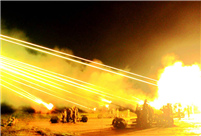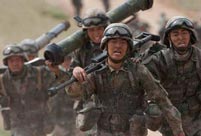

SEOUL, June 11 -- South Korea's hospital system needs to be overhauled to prevent the recurrence of an ongoing Middle East Respiratory Syndrome (MERS) crisis here, co-head of the World Health Organization (WHO)-South Korea joint mission said Wednesday.
"As (MERS) patients developed symptoms, they visited big hospitals with better facilities and equipment without any prior notice. It resulted in infections of medical staffs and families of the patients in defenseless state," Dr. Lee Jong-koo, chief of JW LEE Center for Global Medicine under Seoul National University College of Medicine, said in a written interview with Xinhua.
Lee is co-heading the joint mission along with Dr. Keiji Fukuda, assistant director-general for health security at the WHO. The 16- member team is scheduled to end its five-day joint study of the country's MERS spread by Saturday.
MERS infections here surged to 122 on Thursday, just three weeks after the first case was reported on May 20. The country has become the most MERS-contagious outside of Saudi Arabia, where the disease emerged first in 2012, and more than 1,000 cases have since been identified.
"In our country, patients are allowed to select a hospital, into which they check, in emergency situations," said Lee, indicating that most of patients flocked into biggest hospitals, where the vast majority of cases were discovered.
Thirty-six infectees came from Pyeongtaek St. Mary's Hospital in the city of the same name, some 60 km south of Seoul, where the patient zero was hospitalized secondly. The first patient infected some 30 others there.
Before arriving at the Pyeongtaek hospital, the 68-year-old man visited a small clinic to get referrals to the bigger hospital. After visiting another small clinic in Seoul, he was referred to the Samsung Medical Center in the capital city where doctors confirmed him as the patient zero of the viral disease.
The 14th patient, who had contracted the virus from the patient zero in Pyeongtaek, checked into the emergency room of the Samsung hospital, infecting a whopping 47 people. Two big hospitals in the central city of Daejeon detected nine and eight MERS cases each.
"It needs to restrict the transfer of patients to emergency rooms without any advance notice," said Dr. Lee.
Most of emergency rooms of South Korea's big hospitals are jam- packed with beds and seats, raising possibility for the spread of contagious diseases within hospitals. The health authorities said no MERS infections have been found outside of hospitals.
Lee also talked of the need to increase the isolation units of lower atmospheric pressure than the surrounding air and the isolation rooms for high-fever patients in emergency wards to prevent the spread of contagious diseases within hospitals. Such units prevent the virus from going outside as air flows from high to low pressure.
South Korea reportedly has only 105 low-pressure isolation units in 17 hospitals nationwide. Single bed rooms, in which MERS infectees can be treated, stand merely at 47 as the remainders are multi-bed rooms.
The health authorities said it would separate confirmed patients from potential carriers by treating them at separate hospitals.
The confirmed patients will be treated at 16 hospitals having low-pressure isolation units. The potential carriers of the virus will get medical care at 32 hospitals, where MERS cases were confirmed or visited in the past.
Dr. Lee expressed a relatively optimistic view about containing the MERS spread as the country has hospitals with advanced facilities and equipment.
"Unlike those in the Middle East, cases that caused pneumonia were less than 50 percent (in South Korea). Fatality rate was about 7 percent, lower than 40 percent known (in the Middle East), " said Lee, attributing the figures to relatively better equipment and facilities in South Korean hospitals.
 School life of students in a military college
School life of students in a military college PLA soldiers operate antiaircraft guns in drill
PLA soldiers operate antiaircraft guns in drill Mysterious “sky road” in Mount Dawagengzha
Mysterious “sky road” in Mount Dawagengzha J-11 fighters in air exercise
J-11 fighters in air exercise Top 16 Chinese cities with the best air quality in 2014
Top 16 Chinese cities with the best air quality in 2014 PLA helicopters travel 2,000 kilometers in maneuver drill
PLA helicopters travel 2,000 kilometers in maneuver drill PLA soldiers conduct 10-kilometer long range raid
PLA soldiers conduct 10-kilometer long range raid Stars who aced national exams
Stars who aced national exams
 Hefei-Fuzhou railway line put into trial operation
Hefei-Fuzhou railway line put into trial operation Pan-democrats must choose wisely for HK
Pan-democrats must choose wisely for HK China's latest air quality threat ground-level ozone
China's latest air quality threat ground-level ozone Duped by extremists
Duped by extremists Rolling through time
Rolling through timeDay|Week